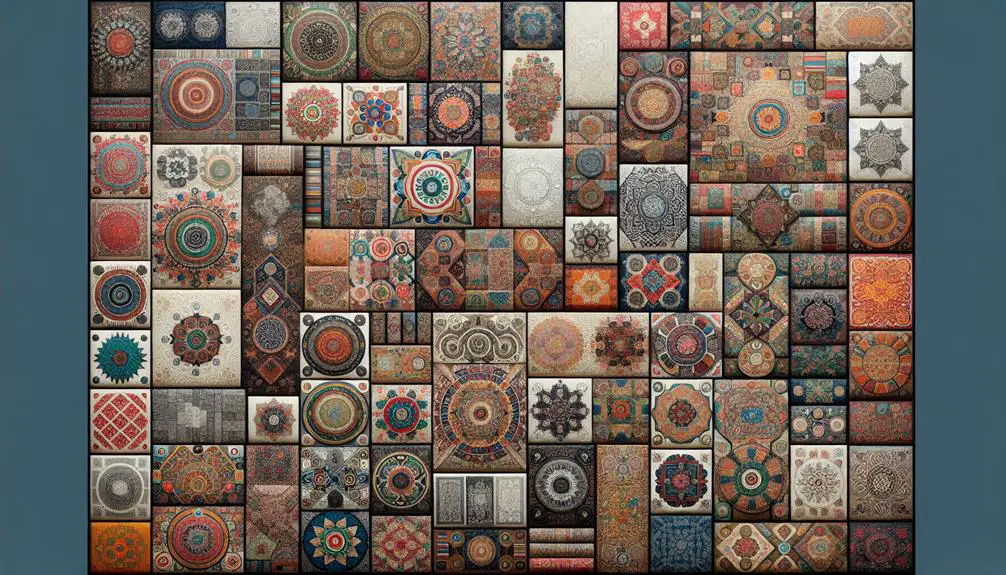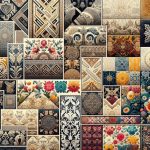Did you know that textile patterns date back over 5,000 years, with some of the earliest examples found in ancient Egyptian tombs? You might find it fascinating how these patterns evolved, reflecting the cultural and societal values of their times. From the symbolic motifs of ancient civilizations to the intricate designs made possible by the Industrial Revolution, textile patterns tell stories that words often can't. But what makes these patterns more than just decorative elements? Understanding their historical development and significance might change how you see a simple piece of fabric.
Table of Contents
Key Takeaways
- Textile patterns evolved from simple designs in ancient civilizations to intricate patterns during the Industrial Revolution.
- Patterns in textiles hold rich symbolism, reflecting cultural identities and societal values.
- Regional variations showcase distinct styles, from Indian saris to Japanese Shibori dyeing.
- Technological advancements like digital printing and smart textiles have revolutionized textile design.
- Global trade facilitated the exchange and hybridization of textile patterns across cultures.
Ancient Textile Patterns
Ancient textile patterns offer a fascinating glimpse into the cultural and artistic expressions of early civilizations. By exploring these intricate designs, you can uncover the traditional techniques that artisans used to create them. Each pattern tells a unique story of its origin, reflecting the values, beliefs, and daily life of the people who crafted them.
In early civilizations, textiles weren't merely functional; they were a canvas for artistic expression. You'd find that traditional techniques like weaving, dyeing, and embroidery were meticulously practiced and passed down through generations. The materials—whether wool, linen, or silk—were chosen with care, and the dyes were sourced from natural elements like plants, minerals, and insects.
Every thread and stitch in these ancient fabrics required skill and precision. As you explore further, you'll notice how different regions developed distinct styles. For example, Egyptian textiles often featured geometric patterns and elaborate borders, while Andean weavers used vibrant colors and complex motifs. These differences highlight the diversity and richness of early civilizations.
Understanding these traditional techniques offers you a deeper appreciation for the craftsmanship and cultural significance embedded in ancient textile patterns. It's a journey into the past, revealing the ingenuity and creativity of our ancestors.
Symbolism in Patterns
Patterns in textiles often carry rich symbolism, revealing cultural narratives and beliefs through their intricate designs. As you explore into the world of textile patterns, you'll discover that each motif is not merely decorative but deeply rooted in tradition and meaning. Understanding the symbolism behind these designs allows you to appreciate the cultural heritage they represent.
For instance, a simple geometric shape can convey complex philosophical ideas or social status. Similarly, floral motifs often symbolize fertility and growth, while animal patterns might represent power, protection, or spiritual guidance. The meanings embedded in these designs are often passed down through generations, preserving the values and stories of the community.
Here's a quick overview of some common symbolic patterns and their meanings:
| Design | Meaning |
|---|---|
| Geometric | Order, balance, harmony |
| Floral | Fertility, life, beauty |
| Animal | Power, protection, spirit |
| Abstract | Innovation, freedom |
Regional Variations
Regional variations in textile patterns offer a fascinating glimpse into the diverse cultural landscapes across the world. When you examine textiles from different regions, you can see how cultural influences shape their unique artistic expressions.
The vibrant hues of Indian saris, for instance, showcase intricate designs that reflect centuries-old traditions. These patterns aren't just decorative; they embody the textile heritage passed down through generations.
In Japan, the meticulous art of Shibori dyeing utilizes traditional techniques to create intricate patterns that are both aesthetically pleasing and culturally significant. Similarly, the geometric motifs found in Moroccan textiles are steeped in history, each pattern telling a story of its own. These artistic expressions are more than mere fabric designs; they're a window into the soul of a culture.
Exploring South American textiles, you'll find the vibrant, bold patterns of Andean weavings. Each piece is crafted using methods that have endured for centuries, reflecting the region's rich textile heritage. These traditional techniques aren't just about creating fabric; they preserve the cultural narratives and identities of the people.
Technological Advancements
Technological advancements in textile production have revolutionized the industry, enabling more intricate designs and faster manufacturing processes. You can now achieve unprecedented precision and detail in your textile patterns thanks to cutting-edge innovations.
Let's explore some key developments that have transformed the landscape:
- Digital Printing: This technique allows you to transfer complex designs directly onto fabric using digital files. It's faster and more flexible than traditional methods, enabling rapid prototyping and customized patterns.
- Sustainable Practices: The industry is shifting towards eco-friendly materials and processes. You can now create beautiful textiles while reducing your environmental footprint, utilizing organic fibers and non-toxic dyes.
- Automation: Advanced machinery and robotics have streamlined production lines. You can produce textiles at a higher volume and consistent quality, reducing labor costs and production errors.
- Smart Textiles: Innovations in fabric technology have led to textiles with embedded sensors and responsive elements. These smart textiles can adapt to environmental conditions, enhancing both functionality and aesthetic appeal.
Cultural Significance
Throughout history, textile patterns have not only adorned fabrics but also conveyed cultural identities and traditions. When you explore the world of textiles, you discover a rich tapestry of artistic interpretations and folk traditions that span centuries. Each pattern tells a story, rooted in the historical context and imbued with social meanings unique to its origin.
Consider the following examples:
| Region | Pattern Type | Cultural Significance |
|---|---|---|
| Japan | Kimono Prints | Reflects nature and seasonal changes |
| West Africa | Kente Cloth | Symbolizes social status and ancestral lineage |
| Scotland | Tartan Plaids | Represents clan identity and heritage |
Textile patterns act as visual narratives, offering insights into the values and beliefs of a society. For instance, Japanese kimono prints often feature motifs from nature, embodying the country's deep respect for the environment. In West Africa, Kente cloth patterns are meticulously designed to convey messages about the wearer's history and community standing.
Patterns in Rituals
You'll notice that textile patterns play an essential role in rituals by symbolizing deeper meanings and cultural values.
These patterns aren't just decorative; they've evolved to represent important aspects of the community's identity.
Understanding their evolution helps you appreciate the rich history and cultural significance embedded in these designs.
Symbolism in Ritual Patterns
Ritual patterns in textiles often carry deep symbolic meanings that reflect cultural beliefs and traditions. These patterns aren't just decorative; they're imbued with significance that reveals much about the values and customs of a community. Understanding these symbols can enrich your appreciation of various traditional practices and their underlying philosophies.
Here are some key aspects to keep in mind:
- Religious Symbols: Many cultures use specific patterns to represent deities, spiritual beliefs, or cosmological concepts. These symbols act as a bridge between the physical and the spiritual realms.
- Social Hierarchies: Textiles often indicate social status, with certain patterns reserved for royalty or other high-ranking individuals. Recognizing these can help you decode historical social structures.
- Rites of Passage: Rituals like weddings or coming-of-age ceremonies frequently feature textiles with patterns symbolizing life shifts, fertility, or protection.
- Cultural Identity: Patterns can serve as a visual language that unites a community, embedding shared history and collective identity within each thread.
Cultural Significance of Textiles
Textiles in rituals often carry profound cultural significance, encapsulating the essence of tradition and communal identity. You're not just looking at a piece of fabric; you're witnessing a tapestry of history and beliefs. Textile symbolism plays a pivotal role in rituals, serving as a medium to convey sacred stories and values.
Each thread and pattern is meticulously chosen to represent specific aspects of cultural evolution. Traditional patterns, deeply rooted in ancestral knowledge, often feature motifs that symbolize protection, fertility, or spiritual connection. These patterns are more than just decorative; they're integral to the ritual's meaning.
For instance, a specific geometric design might signify the cycle of life and death, while intricate floral motifs could represent growth and renewal. In modern interpretations, these traditional patterns are adapted to resonate with contemporary audiences. You'll notice that while the essence remains unchanged, the execution might incorporate new materials or techniques, blending the old with the new.
This fusion not only preserves the heritage but also guarantees its relevance in today's world. By understanding these textiles, you gain insight into the cultural evolution and continuity of those who hold these rituals dear.
Ritualistic Pattern Evolution
As rituals have evolved, the patterns used in ceremonial textiles have also transformed, reflecting changes in cultural practices and societal values. You can see how spiritual symbolism and pattern evolution intertwine in these sacred fabrics. Traditional practices often dictate the design elements, ensuring that each motif carries profound significance.
However, as societies progress and cultural values shift, so do these patterns, adapting to contemporary contexts while still honoring their roots.
Consider the following elements that contribute to the evolution of ritualistic patterns:
- Symbolic Representation: Patterns often incorporate symbols that represent deities, spiritual beliefs, or cosmological elements, adapting to new interpretations over time.
- Material Innovation: Advances in textile production introduce new materials and techniques, influencing the complexity and richness of ceremonial textiles.
- Cultural Exchange: Interaction between different cultures leads to the assimilation and reinterpretation of patterns, blending diverse traditions into cohesive designs.
- Modern Relevance: Contemporary rituals may necessitate updated patterns that resonate with current societal values and spiritual needs.
Evolution Over Time
Tracing the evolution of textile patterns, you'll uncover a rich tapestry of cultural influences and technological advancements. As societies evolved, so did their textiles, reflecting a dynamic interplay of pattern evolution and cultural changes.
Early patterns were often simplistic, using natural dyes and rudimentary tools. However, as civilizations grew, so did the complexity and symbolism of their textile designs.
In ancient Egypt, for instance, you'd find intricate patterns that signified social status and religious beliefs. Fast forward to the Middle Ages in Europe, and you'll see textiles dominated by heraldic symbols and elaborate floral motifs, influenced by the region's shifting political and social landscape.
The Industrial Revolution marked a significant shift. Mechanized looms and synthetic dyes revolutionized textile production, allowing for more intricate and varied patterns. You could now find everything from paisleys to complex geometrics, each reflecting the era's technological prowess and global cultural exchanges.
In contemporary times, digital printing and sustainable practices have further transformed textile patterns. You'll find designs that not only push aesthetic boundaries but also address modern concerns like environmental impact. Understanding the evolution of textile patterns offers you a window into the ever-changing human experience.
Influences of Trade
Trade routes have profoundly shaped the variety and richness of textile patterns across different cultures. By traversing the Silk Road, merchants didn't just transport goods; they facilitated cultural exchange that left an indelible mark on textile artistry. When you examine the intricate designs of textiles, you'll see the unmistakable influences of distant lands.
Consider these key impacts of trade on textile patterns:
- Silk Road: This ancient network connected East and West, enabling the exchange of silk, motifs, and weaving techniques. Chinese silk with its elaborate patterns influenced Persian rugs and European brocades.
- Cultural Exchange: Beyond materials, traders shared aesthetic sensibilities. Patterns from India, like paisley, spread to Persia and Europe, becoming embedded in local customs and designs.
- Global Trade: The Age of Exploration further diversified textile patterns. African textiles incorporated European motifs, while Asian designs found their way into American fabric arts.
- Pattern Adoption: Cultures didn't merely imitate; they adapted foreign patterns to local tastes, resulting in unique hybrid styles. The Japanese adoption and adaptation of Indian chintz into their own kimono fabrics exemplifies this blend.
Understanding these influences helps you appreciate the global tapestry of textile traditions, woven with threads of shared history and artistic innovation.
Modern Interpretations
Today, you can see the rich legacy of historical trade in the vibrant, contemporary interpretations of textile patterns. Designers and artisans have skillfully woven traditional motifs with modern aesthetics, creating pieces that are both timeless and innovative. These contemporary adaptations often incorporate technology, such as digital printing and laser cutting, to push the boundaries of textile design.
You'll notice that artistic expressions in modern textiles aren't just about beauty but also about storytelling and cultural dialogue. Artists draw from a global palette, blending influences from different eras and regions to create unique, expressive designs. This fusion results in textiles that speak to a shared human experience, while still honoring their diverse origins.
Moreover, contemporary adaptations often reflect current social and environmental consciousness. Sustainable practices, such as using organic materials and eco-friendly dyes, are increasingly common. As a result, modern textiles carry a message of responsibility and innovation.
Preserving Heritage
Preserving heritage in textile patterns involves a dedicated effort to maintain and celebrate traditional techniques and motifs. You can actively contribute to heritage preservation by following these key steps:
- Learn and Teach: Immerse yourself in the study of traditional craftsmanship. By understanding the nuances of ancient weaving, dyeing, and embroidery techniques, you can pass this knowledge to future generations.
- Support Artisans: Seek out and support local artisans who practice traditional methods. Your patronage helps sustain their livelihoods and encourages the continuation of age-old skills.
- Document and Archive: Participate in documenting and archiving historical patterns and techniques. Photographs, written descriptions, and video tutorials make certain that these precious traditions aren't lost over time.
- Incorporate Tradition: Blend traditional motifs into modern designs. This not only keeps the patterns alive but also introduces them to a broader, contemporary audience.
Frequently Asked Questions
How Are Textile Patterns Typically Categorized in Museums and Collections?
You won't believe how meticulously textile patterns are categorized in museums! They're sorted by cultural preservation and artistic interpretation, ensuring each piece's profound story and artistry can be fully appreciated by passionate seekers of mastery like you.
What Are the Environmental Impacts of Producing Traditional Textile Patterns?
You'll find that the environmental impact of producing traditional textile patterns can be significant. Embrace sustainability initiatives to reduce waste, conserve resources, and promote eco-friendly practices, ensuring a more sustainable future for textile production.
How Do Textile Patterns Influence Modern Fashion Trends?
You'll notice textile patterns heavily influence modern fashion trends through cultural influences and artistic interpretations. Designers leverage innovation and technological advancements to create unique, contemporary styles that honor traditional motifs while pushing creative boundaries.
What Are Some Common Techniques for Restoring Damaged Textile Patterns?
To restore damaged textile patterns, you'll use conservation methods and textile restoration techniques like re-weaving, patching, and dyeing. Master preservation methods such as vacuuming and humidity control to guarantee long-term care and repair techniques.
How Can One Authenticate the Age and Origin of a Textile Pattern?
You can authenticate the age and origin of a textile pattern by employing dating techniques and origin authentication methods. Analyze the historical context and cultural significance to guarantee accurate identification and deepen your understanding of the textile's provenance.
- How Does Ring Spun Cotton Affect Garment Fit and Shape Retention? - August 13, 2024
- What Are the Challenges in Producing Ring Spun Cotton? - August 13, 2024
- Is Ring Spun Cotton Suitable for Plus-Size Clothing? - August 13, 2024







